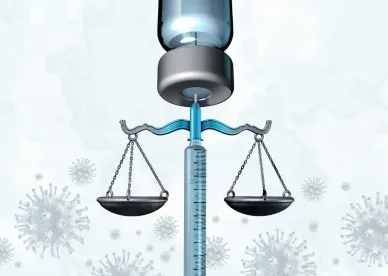On Friday, January 7, 2022, the Supreme Court of the United States heard oral arguments on challenges to the Occupational Safety and Health Administration’s (OSHA) COVID-19 Vaccination and Testing Emergency Temporary Standard (ETS) and the Centers for Medicare and Medicaid Services’ (CMS) COVID-19 vaccination mandate for certain healthcare providers.
In a marathon hearing lasting more than 3.5 hours, all justices peppered the advocates with a wide variety of questions. The takeaway, for now, is everyone will have to wait for rulings in each case before knowing exactly how the justices will handle each of these regulatory schemes. At least because of the OSHA ETS imminent January 10, 2022, deadline, we can expect a ruling of some kind between now and Monday, January 10, 2022, on that regulatory scheme. The first deadline for compliance with the CMS rule is not until January 27, 2022, so the Court may take a little more time addressing those regulations.
OSHA COVID-19 Vaccination and Testing ETS
On December 17, 2021, the United States Court of Appeals for the Sixth Circuit dissolved a stay of OSHA’s COVID-19 Vaccination and Testing ETS. Several challengers to the ETS immediately filed with the Supreme Court emergency applications to reimpose the stay. The Supreme Court consolidated the applications, ordered a quick briefing schedule, and scheduled oral argument. Here is a recap of the major issues discussed during oral argument.
Several justices focused on the applicability of the Major Questions Doctrine. Justice Gorsuch specifically noted that while the Occupational Safety and Health (OSH) Act of 1970 gives OSHA broad powers to impose safety and health regulations in the workplace, Congress clearly did not contemplate the possibility of a pandemic raging across the country and affecting 80 million workers when it passed the law in 1970. Justice Kagan countered by noting that the OSH Act gives the agency broad authority to impose workplace safety and health regulations, but that does not make it vague. Courts should not require Congress to reauthorize this authority, she said, solely because the ETS “is a big deal.” Justice Kavanaugh tested both sides on this issue. Given that COVID-19 is undoubtedly an emergency, he asked the challengers, “Why shouldn’t we defer to the government” in its efforts to combat the spread of COVID-19 in the workplace? But he also noted to the solicitor general, representing OSHA, that the OSH Act could be read as vague or cryptic on whether it squarely addressed the agency’s authority to address vaccines.
Another issue of focus was whether OSHA had authority to regulate hazards that also exist outside the workplace. Several justices expressed skepticism over this potential limitation on OSHA’s authority. Justice Thomas suggested a danger could become so acute in the country that it reaches a point where the government can regulate it in the workplace. Justice Breyer noted that fire is a universal hazard, and there is no doubt OSHA can regulate fire risks in the workplace.
The ETS challengers argued that the federal government lacked authority to impose vaccine mandates, which is normally reserved to the states’ police power, but conceded any employer could voluntarily impose a vaccine mandate on its employees. One of the challengers’ attorneys, Solicitor General of Ohio Benjamin Flowers, agreed with Justice Thomas that Ohio could implement the provisions of the ETS within its borders.
Justice Barrett and Chief Justice Roberts asked whether OSHA should have issued an ETS targeting high-risk workplaces, such as meatpacking plants, instead of issuing a single universal rule that applies to all companies with 100 or more employees. The challengers rejected this as an acceptable proposal, asserting that the entire ETS is “far beyond the line” of the agency’s emergency rulemaking authority. Solicitor General Elizabeth Prelogar posited that while certain workplaces had extremely high risk of exposure to COVID-19, every workplace covered by the ETS had a “baseline level of risk” that met the “grave danger” requirement of the OSH Act’s emergency rulemaking authority. Similarly, Justice Kagan and Justice Breyer identified various exceptions already in the ETS and suggested it already is tailored.
The justices sparred over the use of the term “vaccine mandate.” Justice Alito invoked the term; Justice Kagan and Justice Sotomayor responded that the ETS is not a vaccine mandate. Rather, the ETS permits employers to offer employees the option of either getting vaccinated or being subject to weekly testing and a masking mandate, they noted, and cut off any suggestion that the ETS was a “vaccine mandate.”
There was little discussion over whether COVID-19 presented a “grave danger” to the U.S. workforce. Early in the argument, Scott Keller, attorney for one of the challengers, essentially conceded that COVID-19 was a “grave danger,” which seemed to push that issue to the backburner.
Justice Alito suggested the possibility of the Court issuing a brief administrative stay of the ETS, until the Court announces a decision. Solicitor General Prelogar pushed back on this, suggesting the compliance obligations that go into effect on January 10, 2022, pose little burden on employers. Justice Breyer also rejected the idea of a stay, noting that COVID-19 is getting worse every day, stating the United States now has approximately 750,000 new COVID-19 infections every day.
CMS Vaccine Rule
The U.S. Court of Appeals for the Fifth Circuit, on December 15, 2021, stayed, in part, a nationwide preliminary injunction prohibiting the CMS from enforcing its healthcare vaccination mandate. Specifically, the court stayed the injunction as to states that were not a party to the lawsuit but left the injunction in effect for the 14 plaintiff states. On the same day, a federal court in Texas issued a preliminary injunction that prohibited the CMS from moving forward with implementing or enforcing the mandate in that state.
These orders followed a limited injunction issued by a Missouri court that applied to only the 10 plaintiff states in that case and a Florida federal court’s denial of a motion for a temporary restraining order or preliminary injunction in a lawsuit filed by that state. Thus, as of December 15, 2021, the CMS vaccine mandate was enjoined in 25 states and enforceable in 25 states.
CMS filed a request for the Supreme Court to issue a stay of all of the injunctions. The applications were referred to the entire Court for consideration and the cases were consolidated. As with the OSHA case, the oral argument was scheduled for January 7, 2022. Here is a recap of the major issues discussed during oral argument.
The arguments surrounding the healthcare vaccine mandate were much shorter than the OSHA arguments, and there were fewer points of disagreement on display amongst the justices. The arguments started with a discussion of preemption and standing. Justice Thomas and Justice Kavanaugh, in particular, had questions about this issue. Justice Kavanaugh opined that the situation surrounding the healthcare mandate is unique because the individuals being regulated—the healthcare facilities and providers—are not parties to the case. In fact, he said many of those professional groups “overwhelmingly appear to support the regulations.” The states argued that they have standing based on principles of preemption, as protectors of their citizens’ rights (parens patriae), and because they administer the Medicaid program. Justice Thomas stated that he thought this would be an important issue, but the overall argument seemed to focus elsewhere.
The majority of the argument focused on what Congress meant when it provided the secretary of the Department of Health and Human Services with the ability to establish regulations concerning the “health and safety” of Medicare and Medicaid patients. Justice Sotomayor quickly pointed out that the CMS regulations pose an entirely different issue than the OSHA ETS because the CMS rule is ultimately based on Congress’s constitutional authority to tax citizens and spend money, which has long provided a basis for the CMS to attach significant requirements and strings to the Medicare and Medicaid funds it provides to the states and healthcare providers. Principal Deputy Solicitor General Brian Fletcher readily agreed and none of the other justices chimed in—either pro or con—on this issue and argument.
Justice Kagan also focused on the idea that the purpose of CMS regulations is to protect the health and safety of this patient population and argued that a vaccine requirement that stops providers from being carriers of a deadly disease is squarely within that purpose and authority. The states generally conceded that CMS can regulate health and safety requirements within Medicare- and Medicaid-participating facilities but argued that a vaccine requirement is beyond the scope of that authority because vaccines are invasive medical procedures and an employee cannot remove a vaccine once he or she leaves work, unlike gloves or scrubs. The justices repeatedly pressed the states on this issue, and the arguments became contentious at times. At one point, Justice Kagan stated that she thought it was a basic principle that CMS could require that providers not kill their patients by being carriers of a deadly disease.
Justice Barrett asked several questions about whether the CMS rule could be valid with regard to some of the 15 different types of healthcare facilities implicated by the vaccine mandate—but not all of them—based on the different language in the various statutes creating the authority for the CMS to regulate each type of healthcare facility. Fletcher argued that there was clearly sufficient authority to regulate each of the 15 types of facilities but also seemed to concede that the differing language might be a basis for the Court to allow enforcement of the CMS rule against some types of facilities and not others.
Finally, the Court explored the idea of balancing the equities given that the procedural posture of this case involves a request to stay preliminary injunctions. Justice Breyer asked a few questions along this line. The states argued that rural hospitals would see catastrophic provider losses if the CMS vaccine rule went into effect. Justice Breyer asked how that weighed against the new infection counts seen each day. Justice Kagan stated that the CMS had taken provider losses into account and decided that the losses would not be as significant as the states suggest, and regardless, she asked whether the Court should substitute its judgment for that of the secretary. On rebuttal, the Solicitor General argued that CMS would use discretion in enforcement to help rural areas that may face provider shortages if the rule was strictly enforced.
Unlike in the OSHA argument, there was no mention by the justices of a possible brief administrative stay.
Now, we all wait … hopefully not for too much longer.







 />i
/>i


